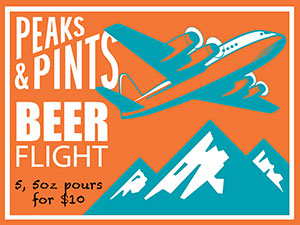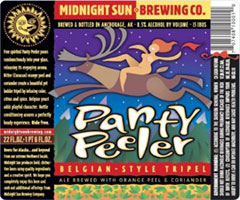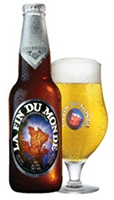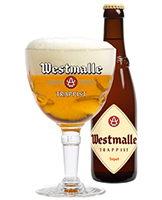 Though strong Belgian pale ales have existed for centuries, the “tripel” name wasn’t used until the Trappists monks at Westmalle Abbey changed the name of what they’d call Superbier, their heaviest pale ale, in 1956. The Flemish Dutch word for triple, tripel suggests three times malt and strength. Much of tripel’s mystique comes from the innocent deep golden color, soft maltiness and customary, intriguing yeast stamp. That is followed by a sucker punch in the range of 8 to 9.5 percent ABV, a combination that offers culinary-quality complexity rivaling any darker brew. The burnished golden color, sometimes glinting of orange, comes from a hefty grist of predominantly mellow, clean Continental pilsner malt. The character is further lightened with the light candi, or white, sugar that Belgian brewers are so fond of, and may comprise up to 20 percent of the fermentables. Tripels are highly popular among beer lovers worldwide, and in North America, even as the import business is as robust as ever, microbrewers are increasingly dabbling in Belgians. Peaks and Pints presents five examples of the style in today’s beer flight: Craft Beer Crosscut 6.6.18: A Flight of Tripels.
Though strong Belgian pale ales have existed for centuries, the “tripel” name wasn’t used until the Trappists monks at Westmalle Abbey changed the name of what they’d call Superbier, their heaviest pale ale, in 1956. The Flemish Dutch word for triple, tripel suggests three times malt and strength. Much of tripel’s mystique comes from the innocent deep golden color, soft maltiness and customary, intriguing yeast stamp. That is followed by a sucker punch in the range of 8 to 9.5 percent ABV, a combination that offers culinary-quality complexity rivaling any darker brew. The burnished golden color, sometimes glinting of orange, comes from a hefty grist of predominantly mellow, clean Continental pilsner malt. The character is further lightened with the light candi, or white, sugar that Belgian brewers are so fond of, and may comprise up to 20 percent of the fermentables. Tripels are highly popular among beer lovers worldwide, and in North America, even as the import business is as robust as ever, microbrewers are increasingly dabbling in Belgians. Peaks and Pints presents five examples of the style in today’s beer flight: Craft Beer Crosscut 6.6.18: A Flight of Tripels.
 Midnight Sun Panty Peeler
Midnight Sun Panty Peeler
8.5% ABV, 15 IBU
Originally named Extreme Polar White Bier, Midnight Sun co-founder Barb Miller nicknamed it “Panty Peeler” after her free spirited and loving life attitude. In French, it translates to E’pluche-culotte, although that might also mean pantyhose. We digress. This candy-sweet tripel’s nose emits plenty of tingly clove and allspice bordered by Belgian yeast-derived bubblegum; the same clove and bubblegum coast over a white bread malt backbone on the tongue. Bottle conditioning creates the right effervescence for a perfectly heady experience.
 Unibroue Fin du Monde
Unibroue Fin du Monde
9% ABV, 19 IBU
Unibroue‘s Fin du Monde translates as “The End of The World.” If this beer is any indication of the end of the world, bring on the apocalypse! This tripel actually reminds us of the beach with the golden orange color providing the sunset, the pineapple and nut aromas giving it a tropical nose, and the strong alcoholic taste, followed by sweetness, completes the sense of drinking on the beach, minus the cocktail and the mini-umbrella. Even with its tropical vibes, La Fin du Monde upholds its light Belgian character. A honey sweetness is tempered by a moderate bitterness that comes in late, tongue tickling and peppery. It’s clear why this is so well loved among craft beer enthusiasts. Exotic and ethereal, it rises above the level of mere beer.
 Anderson Valley Brother David’s Triple
Anderson Valley Brother David’s Triple
10% ABV, 27 IBU
Anderson Valley Brewing‘s Brother David is named after David Keene, one of America’s most iconic publicans and owner of San Francisco’s Toronado Pub. Keene is known for his affinity for good Belgian beers. Brother David pours deep gold in color — a little dark for the style — and shows off a beautiful creamy, tan head. The aroma delivers tones of lemon citrus and lemon grass infused with hints of pepper and yeast. Some breadiness is detected, too. Further into the rather complex nose were wafts of banana and green apple. The flavor follows the nose — lemon citrus and lemon grass intertwined with some white bread, green apple skins and subtle banana. The finish is sweet with an enduring honeylike aftertaste.
Pike Monk’s Uncle
9% ABV, 34 IBU
Pike Brewing Company‘s founders and owners, Charles and Rose Ann Finkel, introduced American beer drinkers to Belgian beers in the 1980s through their craft beer importing company, Merchant du Vin. Pike Monk’s Uncle is their only year-round Belgian style beer and continues the tradition of introducing American palates to the joys of Belgian style beers. This Belgian-style tripel pours traditional golden straw color of the style together with a solid lacy head that remains throughout. There is an overall fruity background flavor to this brew, with just a hint of honey and a touch of spice.
 Brouwerij der Trappisten van Westmalle Tripel
Brouwerij der Trappisten van Westmalle Tripel
9.5% ABV, 36 IBU
In 1836 the Belgian Westmalle monastery became a Trappist Abbey and began brewing beer shortly thereafter. The holy suds they produced started out as an insider-only deal — a choice beverage to be made and enjoyed by Trappists and Trappists alone, but eventually they decided to expand and opened up a public beer hall in the early 1930s. Westmalle embodies the tripel style with a thoughtful balance of sweet, fresh pear, lemon zest and a dash of peppery spice. Its flirtatious effervescence sweeps the mouth clean, while lingering lemony hops leave the mouth pining for more. It’s an exceptional beer, with a great deal of finesse and elegance and a splendid enduring aftertaste.
